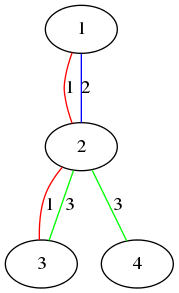Mr. Kitayuta has just bought an undirected graph consisting of n vertices and m edges. The vertices of the graph are numbered from 1 to n. Each edge, namely edge i, has a color ci, connecting vertex ai and bi.
Mr. Kitayuta wants you to process the following q queries.
In the i-th query, he gives you two integers — ui and vi.
Find the number of the colors that satisfy the following condition: the edges of that color connect vertex ui and vertex vi directly or indirectly.
The first line of the input contains space-separated two integers — n and m (2 ≤ n ≤ 100, 1 ≤ m ≤ 100), denoting the number of the vertices and the number of the edges, respectively.
The next m lines contain space-separated three integers — ai, bi (1 ≤ ai < bi ≤ n) and ci (1 ≤ ci ≤ m). Note that there can be multiple edges between two vertices. However, there are no multiple edges of the same color between two vertices, that is, if i ≠ j, (ai, bi, ci) ≠ (aj, bj, cj).
The next line contains a integer — q (1 ≤ q ≤ 100), denoting the number of the queries.
Then follows q lines, containing space-separated two integers — ui and vi (1 ≤ ui, vi ≤ n). It is guaranteed that ui ≠ vi.
For each query, print the answer in a separate line.
4 5
1 2 1
1 2 2
2 3 1
2 3 3
2 4 3
3
1 2
3 4
1 4
2
1
0
5 7
1 5 1
2 5 1
3 5 1
4 5 1
1 2 2
2 3 2
3 4 2
5
1 5
5 1
2 5
1 5
1 4
1
1
1
1
2
Let's consider the first sample.
 The figure above shows the first sample.
The figure above shows the first sample.- Vertex 1 and vertex 2 are connected by color 1 and 2.
- Vertex 3 and vertex 4 are connected by color 3.
- Vertex 1 and vertex 4 are not connected by any single color.
给定n个点和m条边,点编号从1~n,每条边有:起点,终点和颜色
问给定任意两点,求连接这两点所有颜色的数量.(如:红色要连接两个点,那么这两点间必须存在一条颜色为红色的路径,即两点连通于红色)
求连通性很容易想到并查集.将每种颜色看成一个并查集,要求两点之间所有颜色时只需遍历所有颜色,看有多少种颜色能连通即可.
#include <iostream>
using namespace std;
class bingchaji
{
public:
bingchaji()
{
init();
}
int father[200];
void init()
{
for(int i=0;i<200;i++)
father[i]=i;
}
void unit(int u,int v)
{
father[getfather(u)]=father[getfather(v)];
}
int getfather(int v)
{
if(father[v]==v)
return v;
return father[v]=getfather(father[v]);
}
bool same(int u,int v)
{
return getfather(u)==getfather(v);
}
}color[200];
int main()
{
int n,m;
cin>>n>>m;
for(int i=1;i<=m;i++)
{
int u,v,c;
cin>>u>>v>>c;
color[c].unit(u,v);
}
int k;
cin>>k;
for(int i=1;i<=k;i++)
{
int u,v;
int res=0;
cin>>u>>v;
for(int j=1;j<=m;j++)
{
if(color[j].same(u,v))
res++;
}
cout<<res<<endl;
}
return 0;
}